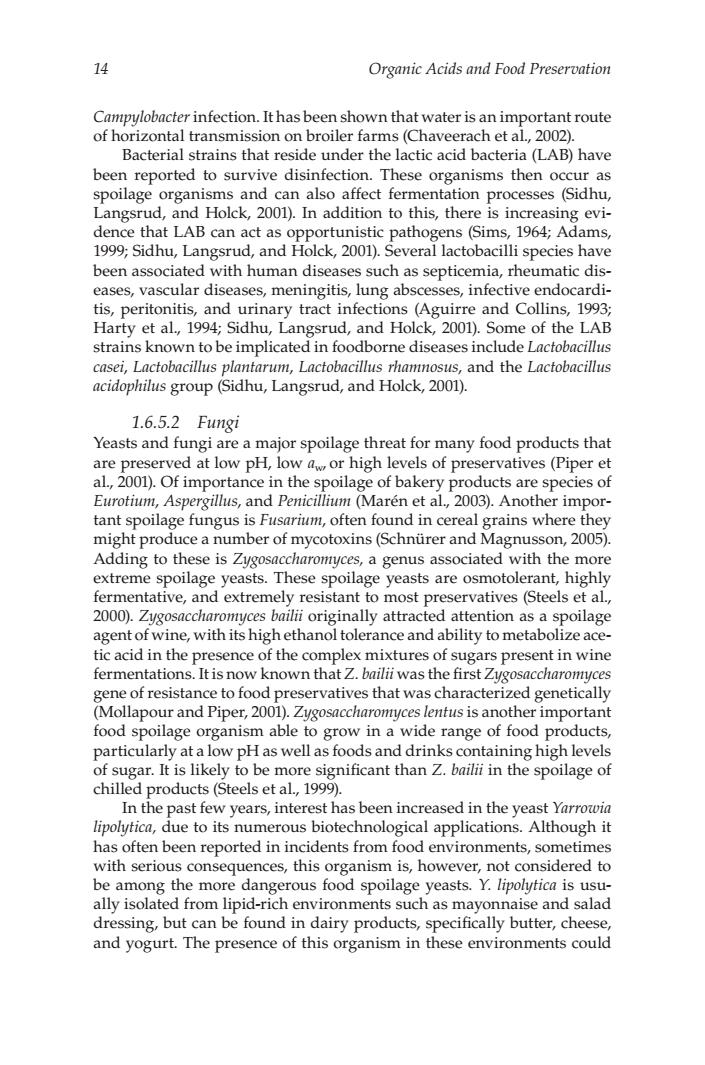正在加载图片...

14 Organic Acids and Food Preservation Campylobacter infection.thasbenshown that water is ansmissi ortant route trains that res the lactic acid bacteria LA d been reported to survive disinfection.These organisms then occur as spoilage organisms and can also affect fermentation processes (Sidhu, Langsrud,and Holck,2001).In addition to this,there is increasing evi- dence that LAB can act as opportunistic pathogens(Sims,1964;Adams, 1999:Sidhu,Langsrud,and Holck,2001).Several lactobacilli species have associated with human disea such a septi mia,rhe natic dis es,mening tis lung ab infecti urinary tract i Agu Harty et al,1994;Sidhu,Langsrud,and Holck,2001).Some of the LAE strains known to be implicated in foodborne diseases include Lacfobacillus casei,Lactobacillus plantarum,Lactobacillus rhamnosus,and the Lactobacillus acidophilus group (Sidhu,Langsrud,and Holck,2001). 1.6.5.2F1ugi Yeasts and fungi are a major spoilage threat for many food products that ed at low pH,lo w a or high levels of preservatives (Pipere ucts are species o Eurotium,Aspergillus,and Penicillium(Maren et al.2003).Another impor- tant spoilage fungus is Fusarium,often found in cereal grains where they might produce a number of mycotoxins(Schnurer and Magnusson,2005). Adding to these is Zygosaccharomyces,a genus associated with the more extreme spoilage veasts.These spoilage veasts are osmotolerant.highlv fermentative and e resistant to most vatives(Steels et al. 2000.7 nally attra agent tic acid in the presence of the complex mixtures of sugars present in wine fermentations.It is now known that Z.bailii was the first Zygosaccharomyces gene of resistance to food preservatives that was characterized genetically (Mollapour and Piper,2001).Zygosaccharomyces lentus is another important food spoilage organism able to grow in a wide range of food products, particularly at a low pH as well as foods and drinks containing high levels of s gar.It is likely chilled gnificant than Z.bailii in the spoilage of (Stee 1,19 in the past f w years,interes st ha as been increased in the yeast Yarro lipolytica,due to its numerous biotechnological applications.Although it has often been reported in incidents from food environments,sometimes with serious consequences,this organism is,however,not considered to be among the more dangerous food spoilage veasts.Y.lipolyfica is usu- ally isolated from lipid-rich environments such as mayonnaise and salad dressing,but can be found in dairy products,specifically butter,chee and yogurt.The presence of this organism in e environments could14 Organic Acids and Food Preservation Campylobacter infection. It has been shown that water is an important route of horizontal transmission on broiler farms (Chaveerach et al., 2002). Bacterial strains that reside under the lactic acid bacteria (LAB) have been reported to survive disinfection. These organisms then occur as spoilage organisms and can also affect fermentation processes (Sidhu, Langsrud, and Holck, 2001). In addition to this, there is increasing evidence that LAB can act as opportunistic pathogens (Sims, 1964; Adams, 1999; Sidhu, Langsrud, and Holck, 2001). Several lactobacilli species have been associated with human diseases such as septicemia, rheumatic diseases, vascular diseases, meningitis, lung abscesses, infective endocarditis, peritonitis, and urinary tract infections (Aguirre and Collins, 1993; Harty et al., 1994; Sidhu, Langsrud, and Holck, 2001). Some of the LAB strains known to be implicated in foodborne diseases include Lactobacillus casei, Lactobacillus plantarum, Lactobacillus rhamnosus, and the Lactobacillus acidophilus group (Sidhu, Langsrud, and Holck, 2001). 1.6.5.2 Fungi Yeasts and fungi are a major spoilage threat for many food products that are preserved at low pH, low aw, or high levels of preservatives (Piper et al., 2001). Of importance in the spoilage of bakery products are species of Eurotium, Aspergillus, and Penicillium (Marén et al., 2003). Another important spoilage fungus is Fusarium, often found in cereal grains where they might produce a number of mycotoxins (Schnürer and Magnusson, 2005). Adding to these is Zygosaccharomyces, a genus associated with the more extreme spoilage yeasts. These spoilage yeasts are osmotolerant, highly fermentative, and extremely resistant to most preservatives (Steels et al., 2000). Zygosaccharomyces bailii originally attracted attention as a spoilage agent of wine, with its high ethanol tolerance and ability to metabolize acetic acid in the presence of the complex mixtures of sugars present in wine fermentations. It is now known that Z. bailii was the first Zygosaccharomyces gene of resistance to food preservatives that was characterized genetically (Mollapour and Piper, 2001). Zygosaccharomyces lentus is another important food spoilage organism able to grow in a wide range of food products, particularly at a low pH as well as foods and drinks containing high levels of sugar. It is likely to be more significant than Z. bailii in the spoilage of chilled products (Steels et al., 1999). In the past few years, interest has been increased in the yeast Yarrowia lipolytica, due to its numerous biotechnological applications. Although it has often been reported in incidents from food environments, sometimes with serious consequences, this organism is, however, not considered to be among the more dangerous food spoilage yeasts. Y. lipolytica is usually isolated from lipid-rich environments such as mayonnaise and salad dressing, but can be found in dairy products, specifically butter, cheese, and yogurt. The presence of this organism in these environments could